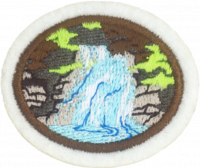Difference between revisions of "AY Honors/Waterfalls/Answer Key/en"
(Updating to match new version of source page) |
(Updating to match new version of source page) |
||
| Line 173: | Line 173: | ||
<noinclude></noinclude> | <noinclude></noinclude> | ||
==References== | ==References== | ||
| − | |||
| − | |||
<noinclude></noinclude> | <noinclude></noinclude> | ||
| + | [[Category:Adventist Youth Honors Answer Book/Do at home{{GetLangSuffix}}]] | ||
{{CloseHonorPage}} | {{CloseHonorPage}} | ||
Revision as of 20:41, 13 July 2022
1
1a
In a block waterfall, water descends from a relatively wide stream or river.
1b
In a cascade waterfall, water descends a series of rock steps.
1c
In a horsetail waterfall, descending water maintains some contact with bedrock.
1d
In a plunge waterfall, water descends vertically, losing contact with the bedrock surface.
1e
In a segmented waterfall, distinctly separate flows of water form as it descends.
1f
In a tiered waterfall, water drops in a series of distinct steps or falls.
2
The two from your area will depend on your area. Here is an example to start your research with:
Name: Niagara Falls is actually three falls. From largest to smallest, the three waterfalls are the Horseshoe Falls, the American Falls and the Bridal Veil Falls. The Horseshoe Falls lie on the Canadian side and the American Falls on the American side, separated by Goat Island. The smaller Bridal Veil Falls are also located on the American side, separated from the other waterfalls by Luna Island. The international boundary line was originally drawn through Horseshoe Falls in 1819, but the boundary has long been in dispute due to natural erosion and construction.
Total Height: vertical drop of more than 165 feet (50 m)
Waterfall Type: Block
Watercourse: Niagara River
Location: Between Niagara Falls, Ontario and Niagara Falls, New York.
3
3a
Field trips are always fun. Maybe this visit could count toward the Hiking Honor. That honor requires keeping a record of your hikes so this fits very well. Happy waterfall viewing.
3b
This information should be similar to the example under #2. Don't forget that the eco-system around the waterfall can be just as interesting as the basic statistics of the waterfall itself.
3c
The intent is a meaningful video - not just a 2 minute tourist video.
3d
This could be a paper scrapbook (a good project for the Scrapbooking Honor or perhaps an online "scrapbook" on a webpage. The info gathered for requirement #2 is a good place to start. Have fun.
3e
- Angel/Tallest waterfall in the world at 3212 feet.
- Browne/Tallest waterfall in New Zealand.
- Dettifoss/Waterfall flowing from a glacier in Iceland.
- Havasu/Waterfall on an Indian reservation in Arizona.
- Huangguoshu/Largest waterfall in China.
- Iguazu/275 falls on the border of Argentina and Brazil.
- Langfoss/Giant cascade in Norway, falling 2008 feet.
- Mardalsfossen/Well known tiered waterfall in Norway.
- Multnomah/Tiered waterfall along the Columbia Gorge in Oregon.
- Niagara/Most powerful waterfall in North America.
- Shomyo/Tallest year-round falls in Japan.
- Takkakaw/Cree Indian name for a waterfall in British Columbia.
- Tugela/2nd tallest waterfall in the world, found in South Africa.
- Victoria/Largest waterfall in the world.
- Yosemite/Popular tourist attraction in a National Park in California.
- Yumbilla/5th tallest waterfall in the world, 2nd tallest in Peru.
4
4a
He answered and said, “A Man called Jesus made clay and anointed my eyes and said to me, ‘Go to the pool of Siloam and wash.’ So I went and washed, and I received sight.”
In this verse, a man who was born blind was explaining to the Pharisees how he had been healed of his blindness by Jesus. Rather than recognizing the divinity of Jesus, the Pharisees ignore the fact that Jesus had healed the man's blindness, but rather seized on the detail that Jesus had "made clay" which was "in violation of the Sabbath." They were indeed "straining out a gnat and swallowing a camel." (Matt 23:24).
The water in this verse represents faith, because the blind man was not healed until he acted on faith and washed as instructed. An immediate parallel is the story of Naaman (2 Kings 5) in which Naaman was not healed of his leperosy until he acted on faith as instructed, and washed in the River Jordan.
4b
After that, He poured water into a basin and began to wash the disciples’ feet, and to wipe them with the towel with which He was girded.
This verse takes place during the Last Supper. The disciples had been arguing among themselves about who of them was the greatest, so none of them wanted to stoop down to serve the others by washing their feet. That was a job for the lowliest servant in a household, not for someone who aspired to the Secretary of the State in the New Kingdom. All of them knew that someone needed to perform this task, but none would. The disciples were greatly embarrassed when they realized that Jesus himself was doing this.
The water here represents cleansing from sin. Just as He was the only one willing to take the role of a servant, Jesus Jesus was also the only One able to rid them of their sin.
4c
When He had been baptized, Jesus came up immediately from the water; and behold, the heavens were opened to Him, and He saw the Spirit of God descending like a dove and alighting upon Him.
This verse describes the baptism of Jesus. Baptism represents our own death, burial, and resurrection. We die to ourselves, are "buried" in the water (representing the grave), and then resurrected as new, born again Christians. The water is also cleansing us of our old life of sin.





